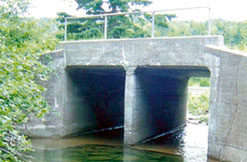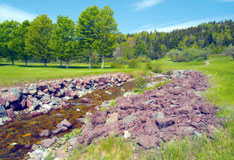page2
Restoration initiative blends with recreational use at high-profile national park facility
Reversing decades of degradation, the restoration of Dickson Brook helps bring ecological integrity to an historic golf course
Years ago, Dickson Brook flowed through farmland, and before that, through Acadian mixed forest. Today, it flows through a nine-hole golf course in Fundy National Park of Canada. Opened in 1950, the golf course was one of the last courses designed by world-renowned landscape architect Stanley Thompson. Although Thompson was an environmentalist, and ahead of his time, his design required re-aligning sections of Dickson Brook. Subsequent modifications further compromised the brook, leaving it in an environmentally degraded condition.
The course was created at a time when there was less understanding of environmental issues in national parks. Attempts to canalize the flow of the brook and prevent damage to the golf course only made Dickson Brook more susceptible to flooding and erosion. Artificial embankment structures designed to channel the water and prevent floods washed out and were replaced several times at considerable environmental and economic cost. The stream channel was narrowed, reducing its ability to accommodate high-water flows triggered by heavy rainfalls. Erosion accelerated, raising concerns that mercury from the past use of pesticides and fungicides on the greens could be released into the aquatic ecosystem.
The natural stream features, such as pools, riffles and large rocks, which provide habitat and cover for fish, had disappeared from Dickson Brook. Improperly installed culverts blocked fish from their spawning and rearing areas, and stream banks lacked the native vegetation that would provide cooler water temperatures for fish and habitat for other wildlife.
 Small bridge over Dickson Brook © Parks Canada / J. Watts / 2003 |
Since then, much has been learned at Canada’s national parks about maintaining ecosystems while still sustaining facilities such as golf courses. Today, Parks Canada is restoring the ecological integrity of Dickson Brook. The benefits are already becoming visible. The multi-year restoration will ensure the playability of the Fundy National Park Golf Course while it continues to reflect much of Stanley Thompson's original design, setting a fine example of ecological integrity initiatives integrated with recreational use.
Canada staff began restoration work in July 2004 on a 200-metre stretch of the brook, reconfiguring a channel meander to allow a more natural flow of water. Large rocks have been placed in the streambed to restore the riffle profile and provide habitat for fish. Planting native trees, shrubs and ground vegetation has stabilized the stream banks and provided habitat for wildlife. Before and after indicators, such as the number of fish in Dickson Brook, will be monitored as the restoration continues.
The benefits of this work will not be limited to Dickson Brook. A video is being made, aimed at park managers and golf course owners who are interested in similar stream restorations. Government departments in Canada and the United States, as well as local universities, have all expressed interest in the project.
Dickson Brook can serve as a model for stream restoration, demonstrating that restoration and recreation need not be incompatible. As an ecologically sound brook flows through his historic course, surely Stanley Thompson would approve.
Results
 Dickson Brook © Parks Canada / B. Townsend / 2003 |
- The restoration of Dickson Brook at the Fundy National Park Golf Course demonstrates Parks Canada’sability to integrate ecological integrity initiatives with the recreational use of a high-profile national park facility.
- The Dickson Brook project moves Parks Canada closer to certification under the Audubon Cooperative Sanctuary Program for Golf Courses, an internationally recognized environmental stewardship program.
- Park staff restored a 200-metre section of Dickson Brook, using innovative stream restoration technology.
- Seven specially designed rock riffles were constructed to restore the natural riffle profile of the brook and provide fish with a passage through a large concrete culvert.
- A video for use by park managers and golf course superintendents interested in similar stream restorations is being developed.
- Date modified :